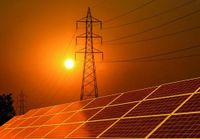Asia stands at a pivotal crossroads in its energy transition, grappling with the twin pressures of decarbonizing its power sector and maintaining economic growth. As of 2024, coal still accounted for more than half of the region’s power mix, according to Rystad Energy. The scale of the challenge is immense: despite ambitious net-zero pledges, the reliance on coal underscores just how far Asia must go to meet its climate targets.
In a bid to rein in emissions, several Asian countries are turning to ammonia as an alternative fuel, particularly through co-firing—blending ammonia with coal or natural gas in power generation. The hope is that ammonia, when paired with carbon capture technologies, can help slash emissions from Asia’s vast fleet of coal-fired power plants. Rystad Energy projects that China, Indonesia, Japan, and South Korea will emerge as leading hubs in this transition, but a sizeable supply gap looms large. By 2030, the region will need around 8.8 million tonnes of ammonia per year to meet its targets, highlighting the daunting scale of investment required.
But the path forward is anything but straightforward. Despite the urgency, Asia lacks the robust policy frameworks and market demand necessary to support large-scale ammonia infrastructure. Resource constraints further complicate matters. Japan and South Korea, for instance, face limited natural gas reserves and insufficient renewable capacity, leaving them heavily reliant on imported clean ammonia to secure their power supply while working to reduce emissions. The region’s dependence on imports raises questions about both energy security and the long-term sustainability of this strategy.
Costs remain a formidable obstacle. Ammonia co-firing is expensive, largely due to the high production costs of low-carbon hydrogen, as well as the expenses associated with conversion and transport. Based on a hydrogen price of $5 per kilogram—equivalent to $1,000 per tonne of ammonia—Rystad Energy estimates that electricity from a 10% ammonia blend would cost around 50% more than coal-only generation. This stark price difference underlines the need for innovation, economies of scale, and meaningful carbon pricing to make ammonia a truly competitive option.
Minh Khoi Le, Head of Hydrogen Research at Rystad Energy, put it succinctly: “Even with high costs associated with hydrogen, ammonia demand from power generation is expected to grow ninefold by 2030. But without firm offtake commitments and faster development of import infrastructure, growth could stall.”
China has adopted the most decisive approach so far. Under the National Development and Reform Commission’s 2024–2027 Action Plan, newly commissioned or upgraded coal plants must halve emissions by 2027 compared with 2023 levels. The plan mandates 10% co-firing of biomass and green ammonia, with carbon capture technologies supporting the transition. Given the sheer size of China’s coal fleet, retrofitting existing plants will be a monumental task, but the country’s abundant renewable resources—especially in Inner Mongolia—give it a strong advantage in scaling up domestic production.
Earlier in 2025, Envision Energy commissioned the world’s largest green ammonia facility in Chifeng, China, with an initial output of 0.32 million tonnes per annum and plans to expand to 1.5 million tonnes by 2028. Such projects could make China not only self-sufficient in green ammonia but also a regional supplier, potentially shifting the balance of power in Asia’s energy landscape.
South Korea, meanwhile, is pursuing hydrogen-for-power through clean hydrogen auctions. Its second round, launched this year, obliges winning bidders to generate electricity using hydrogen or ammonia by 2029 under 15-year contracts. Although the offered volume is smaller than the inaugural round in 2024, it will still require some 200,000 tonnes of low-carbon hydrogen annually. To encourage broader participation, the Ministry of Trade, Industry and Energy has introduced new mechanisms, including an exchange rate-linked settlement system to shield generators from currency fluctuations and a borrowing mechanism to provide flexibility in managing volumes.
Japan, an early mover in ammonia co-firing, is pressing ahead with a strategy based on long-term import contracts and international partnerships. It is securing blue ammonia from the United States and green ammonia from China and India to address domestic shortfalls. Early next year, Japan will also award its first contracts under a contract-for-difference scheme designed to bolster its ammonia-for-power ambitions. This approach, while innovative, illustrates the complexity of building a new energy ecosystem in a region marked by diverse needs and capabilities.
While hydrogen and ammonia are poised to play a central role in decarbonizing Asia’s power sector, the journey is fraught with challenges. High costs and infrastructure barriers remain, and the absence of comprehensive policy frameworks risks slowing progress. Yet, if partnerships, offtake agreements, and retrofitting of coal plants gather pace, ammonia could become a vital stepping stone in Asia’s path to net zero—enabling the region to replace coal as a baseload fuel while protecting energy security.
The story of ammonia in Asia’s energy transition is one of both promise and peril. The region’s determination to decarbonize is clear, but the road ahead will require sustained investment, innovation, and international cooperation. As the world watches, Asia’s choices in the coming years will shape not just its own future, but the global trajectory toward a cleaner, more secure energy system.
In a landscape defined by both ambition and uncertainty, the next chapter in Asia’s energy story will be written by those who can bridge the gap between vision and reality—one molecule of ammonia at a time.




